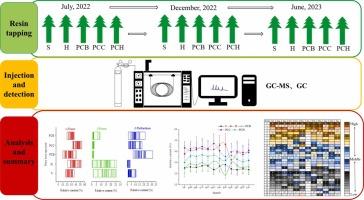Chemical composition characteristics and monthly variation patterns of oleoresins from five introduced pine species
IF 6.2
1区 农林科学
Q1 AGRICULTURAL ENGINEERING
引用次数: 0
Abstract
In order to effectively utilize the oleoresin resources of introduced pine species, the monthly variation patterns of the chemical composition of oleoresin from Pinus elliottii Engelm. (S), Pinus taeda L. (H), Pinus caribaea var. bahamensis (Griseb.) W. H. Barrett & Golfari (PCB), Pinus caribaea var. caribaea Morelet (PCC) and Pinus caribaea var. hondurensis (Sénécl.) W. H. Barrett & Golfari (PCH) were analyzed by gas chromatography-mass spectrometry and gas chromatography. The results showed that the oleoresin from the five introduced pine species was similar in compound types and mainly composed of monoterpenes and diterpenes. The types of compounds remained stable across different months. Oleoresin from five introduced pine species could be easily and quickly distinguished based on the differences in the relative contents of the main compounds (α-pinene, β-pinene, β-phellandrene and isopimaric acid). The relative contents of the main compounds in the oleoresin fluctuated in different months. In months with a significant temperature decrease, both the number of oleoresin-secreting individual plants decreased and the fluctuation range of the main compounds’ relative contents increased. In December, the number of oleoresin-secreting individual of PCB decreased from 30 to 23. In January of the following year, the number of oleoresin-secreting individual of S, H, PCC and PCH decreased from 30 to 16, 21, 19 and 21 respectively. The relative contents of α-pinene, β-pinene, and β-phellandrene in the oleoresin of PCB, PCC, and PCH reached their minimum values in February; conversely, those in the oleoresin of S and H reached their maximum values the in February. This work has important guiding significance for the identification of oleoresin sources, the selection of oleoresin raw materials, the breeding of superior individual plants, and the determination of the optimal resin-tapping time in actual forestry production.

五种引种松木油树脂化学成分特征及月变化规律
为了有效利用引种松木油树脂资源,研究了油松油树脂化学成分的月变化规律。(5),巴西松(H),巴西松(Griseb.)W. H. Barrett & &; Golfari (PCB),加勒比松变种caribaea Morelet (PCC)和加勒比松变种hondurensis (ssamnsamic3 .)采用气相色谱-质谱联用和气相色谱法分析W. H. Barrett & Golfari (PCH)。结果表明,5种引种松木的油树脂化合物类型相似,主要由单萜和二萜组成。化合物类型在不同月份保持稳定。根据主要化合物(α-蒎烯、β-蒎烯、β-茶树烯和异海松酸)相对含量的差异,可以比较容易、快速地区分5种引种松木的油树脂。油树脂中主要化合物的相对含量在不同月份有所波动。在气温明显下降的月份,分泌油树脂的单株数量减少,主要化合物相对含量的波动幅度增大。12月,PCB油树脂分泌个体数由30个减少到23个。次年1月,S、H、PCC和PCH的油树脂分泌个体数分别从30个减少到16个、21个、19个和21个。PCB、PCC和PCH的油树脂中α-蒎烯、β-蒎烯和β-茶树烯的相对含量在2月份达到最小值;相反,S和H的油树脂在2月份达到最大值。该工作对林业实际生产中油树脂来源的鉴定、油树脂原料的选择、优质单株的选育以及最佳采胶时间的确定具有重要的指导意义。
本文章由计算机程序翻译,如有差异,请以英文原文为准。
求助全文
约1分钟内获得全文
求助全文
来源期刊

Industrial Crops and Products
农林科学-农业工程
CiteScore
9.50
自引率
8.50%
发文量
1518
审稿时长
43 days
期刊介绍:
Industrial Crops and Products is an International Journal publishing academic and industrial research on industrial (defined as non-food/non-feed) crops and products. Papers concern both crop-oriented and bio-based materials from crops-oriented research, and should be of interest to an international audience, hypothesis driven, and where comparisons are made statistics performed.
 求助内容:
求助内容: 应助结果提醒方式:
应助结果提醒方式:


